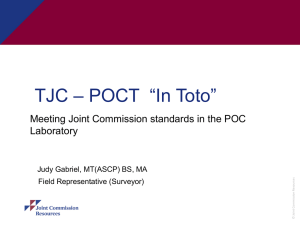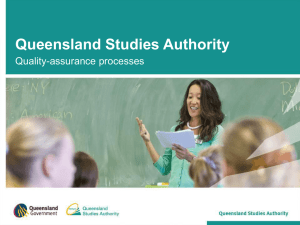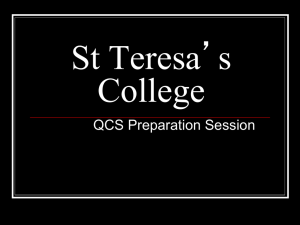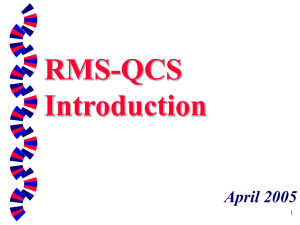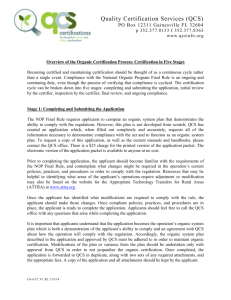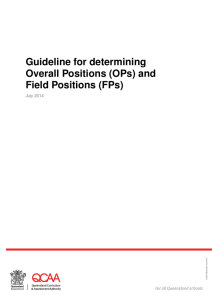Masterclass: Tertiary entrance and senior data interpretation
advertisement
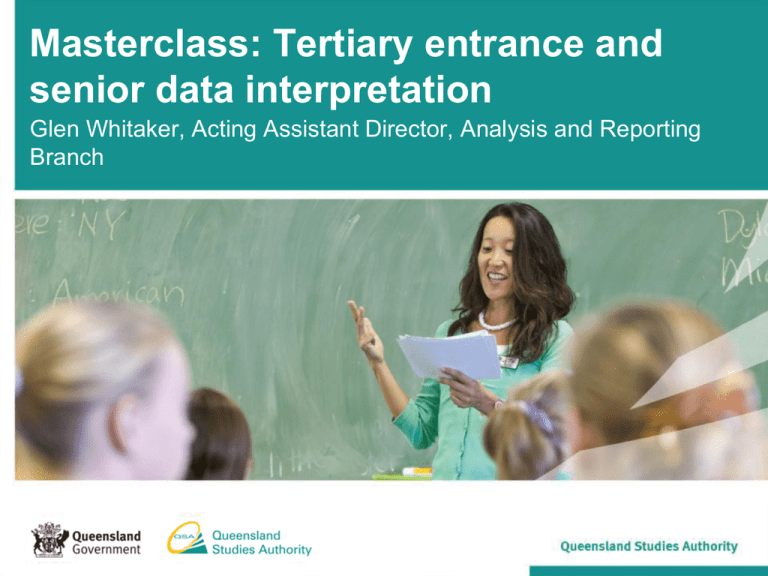
Masterclass: Tertiary entrance and senior data interpretation Glen Whitaker, Acting Assistant Director, Analysis and Reporting Branch Why should I care about OPs now that they are under review? • The OP process is not broken, and will still be here for a few years. • The review is not about “fixing” OPs. • The nature of schooling is changing and becoming more flexible. • Concepts like “schools” are becoming less well defined. • The idea of a lock-step cohort advancing through school is becoming increasingly less a reality. The rest of the country has the same tertiary entrance system, won’t we just join them? • No two jurisdictions calculate their tertiary entrance rank in the same way. • Once students have been ranked using the different methods, there is agreement about how this rank should be reported as an ATAR. • QSA calculates ATARs for students who need them. • We need to separate the debate about how they are calculated from the scale on which they are reported. What we have in common with the other jurisdictions • Everyone needs to scale results in subjects. We need to find a way to compare results in different subjects for the purposes of tertiary entrance. • Everyone currently ranks students within a cohort of students exiting Year 12. • Everyone has school-based assessment contribute to the ranking. Where Queensland is (currently) different • In other jurisdictions there is some sort of scaling done within subjects to come up with a score, and this score is given to the tertiary admission centre to be scaled between subjects. • In Queensland, scaling happens between subjects at a school and then between schools. Both stages are performed at the QSA. Scaling in Queensland • The purpose of scaling in any jurisdiction is to ensure fairness in competitive tertiary entrance. • Comparisons need to be made between students who have studied many different combinations of subjects at different schools. • Most myths about certain subjects or schools being privileged are found in all other jurisdictions. • In fact, scaling is the process to remove these effects. • Comparisons can be made in Queensland using results from a common test – the QCS Test. QCS Test • Designed to measure achievement in CCEs (Common Curriculum Elements) which underpin Authority subjects irrespective of subject content e.g. Analysing, Justifying, Explaining, Extrapolating • Not all CCEs are tested each year • Provides a baseline for comparing groups of students across subjects and schools Gender differences on the test Who has a higher average on the QCS Test – boys or girls – and is this a problem? Gender differences on the test The participation rate for girls is much higher, so relatively few of the poorly achieving boys attempt the test compared to girls. Range and balance on the test The test specification ensures that each year’s test is balanced in terms of nine dimensions: 1.the 49 common curriculum elements (CCEs) 2.attributes (baskets) 3.epistemic content (refer Phenix (1964)) 4.type of stimulus material (numerical/verbal/tabulargraphical/visual) 5.length of stimulus material 6.context (everyday/esoteric) 7.type of response 8.difficulty 9.number of grades (SR). QSA quality assurance and checking processes • ALL SAIs sent in by schools checked for reasonableness and schools contacted if issues. • Procedures for small cohorts. • Reducing the effect of abnormal QCS Test performance. • Group anomaly checking processes. • Individual anomaly checking processes. Group anomaly checking Individual anomaly checking Is it harder to get an OP1-5 now than it was 15 years ago? Year to year comparability of OPs • QCS Test scale scores are not comparable over time. • In order to maintain comparability of OPs, perform a number of exercises to change the cutoffs. • This ensures that an OP1 this year represents the same achievement as in previous years. Gender and OPs • The boys are over-represented (a little) at the top • Girls dominate all of the bands below that to OP14. • This is an internationally known phenomenon, which can be seen in the distribution of the ATARs in other jurisdictions. • It has been the source of a great amount of research. • The differences are exaggerated by the higher participation rate of girls when described as a count. Distribution by count Distribution by percentage What data do we provide? • Information about the performance of the OP-eligible group on the QCS Test. • Graphs showing the match between within-school achievement and QCS Test performance. • Subject enrolments. QSA data is available on the secure QSA website in February each year. Using and interpreting the data • We try to give schools as much data as possible. • Not all data is particularly useful — some graphs are more useful than others. • The data probably won’t tell schools things that are completely unexpected. • It can help identify trends and diagnose where issues might exist. • It is important to approach the data in terms of what stories it can tell to help me improve what I do, and interpret it in the context in which it took place. Influences on trends • • • • • • Population Eligibility Demographics Subject selection Statistical uncertainty Teaching is not the only effect on the data What should schools look for? • Trends over time: unusual occurrences may not be that significant • Look beyond the quantitative: analyse Forms R6, review student work Campbell’s law “The more any quantitative social indicator is used for social decision-making, the more subject it will be to corruption pressures and the more apt it will be to distort and corrupt the social processes it is intended to monitor.” “When a measure becomes a target, it ceases to be a good measure.” Tertiary entrance resources on the QSA website • www.qsa.qld.edu.au • Choose Senior Secondary>Tertiary Entrance for general information as well as publications: – OP Fast Facts – OP Myths – Calculating OPs – the basic principles – Student Connect – Eligibility for Field Positions – Procedures for calculating OPs and FPs (technical information)




